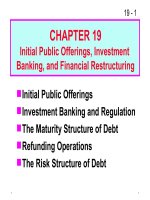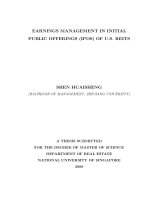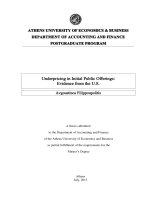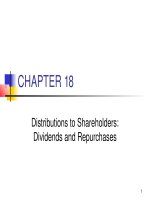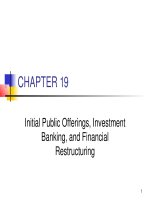Lecture Managerial finance - Chapter 19: Initial public offerings, investment banking, and financial restructuring
Bạn đang xem bản rút gọn của tài liệu. Xem và tải ngay bản đầy đủ của tài liệu tại đây (449.31 KB, 31 trang )
CHAPTER 19
Initial Public Offerings, Investment
Banking, and Financial
Restructuring
1
Topics in Chapter
Initial Public Offerings
Investment Banking and Regulation
The Maturity Structure of Debt
The Risk Structure of Debt
2
What agencies regulate
securities markets?
The Securities and Exchange
Commission (SEC) regulates:
Interstate public offerings.
National stock exchanges.
Trading by corporate insiders.
The corporate proxy process.
The Federal Reserve Board controls
margin requirements.
(More...)
3
States control the issuance of securities
within their boundaries.
The securities industry, through the
exchanges and the National Association
of Securities Dealers (NASD), takes
actions to ensure the integrity and
credibility of the trading system.
Why is it important that securities
markets be tightly regulated?
4
How are startup firms usually
financed?
Founder’s resources
Angels
Venture capital funds
Most capital in fund is provided by
institutional investors
Managers of fund are called venture
capitalists
Venture capitalists (VCs) sit on boards of
companies they fund
5
Differentiate between a private
placement and a public offering.
In a private placement, such as to
angels or VCs, securities are sold to a
few investors rather than to the public at
large.
In a public offering, securities are
offered to the public and must be
registered with SEC.
(More...)
6
Privately placed stock is not registered,
so sales must be to “accredited” (high
net worth) investors.
Send out “offering memorandum” with 20
30 pages of data and information, prepared
by securities lawyers.
Buyers certify that they meet net
worth/income requirements and they will
not sell to unqualified investors.
7
Why would a company consider
going public?
Advantages of going public
Current stockholders can diversify.
Liquidity is increased.
Easier to raise capital in the future.
Going public establishes firm value.
Makes it more feasible to use stock as
employee incentives.
Increases customer recognition.
(More...)
8
Disadvantages of Going
Public
Must file numerous reports.
Operating data must be disclosed.
Officers must disclose holdings.
Special “deals” to insiders will be more
difficult to undertake.
A small new issue may not be actively
traded, so marketdetermined price may
not reflect true value.
Managing investor relations is time
9
consuming.
What are the steps of an IPO?
Select investment banker
File registration document (S1) with
SEC
Choose price range for preliminary (or
“red herring”) prospectus
Go on roadshow
Set final offer price in final prospectus
10
What criteria are important in
choosing an investment banker?
Reputation and experience in this
industry
Existing mix of institutional and retail
(i.e., individual) clients
Support in the postIPO secondary
market
Reputation of analyst covering the stock
11
Would companies going public use a
negotiated deal or a competitive bid?
A negotiated deal.
The competitive bid process is only
feasible for large issues by major firms.
Even here, the use of bids is rare for equity
issues.
It would cost investment bankers too much
to learn enough about the company to
make an intelligent bid.
12
What would the sale be on an
underwritten or best efforts basis?
Most offerings are underwritten.
In very small, risky deals, the
investment banker may insist on a best
efforts basis.
On an underwritten deal, the price is not
set until
Investor interest is assessed.
Oral commitments are obtained.
13
Describe how an IPO would
be priced.
Since the firm is going public, there is
no established price.
Banker and company project the
company’s future earnings and free
cash flows
The banker would examine market data
on similar companies.
(More...)
14
Price set to place the firm’s P/E and
M/B ratios in line with publicly traded
firms in the same industry having similar
risk and growth prospects.
On the basis of all relevant factors, the
investment banker would determine a
ballpark price, and specify a range
(such as $10 to $12) in the preliminary
prospectus.
15
(More...)
What is a roadshow?
Senior management team, investment
banker, and lawyer visit potential
institutional investors
Usually travel to ten to twenty cities in a
twoweek period, making three to five
presentations each day.
Management can’t say anything that is
not in prospectus, because company is
in “quiet period.”
16
What is “book building?”
Investment banker asks investors to
indicate how many shares they plan to
buy, and records this in a “book”.
Investment banker hopes for
oversubscribed issue.
Based on demand, investment banker
sets final offer price on evening before
IPO.
17
What are typical firstday
returns?
For 75% of IPOs, price goes up on first
day.
Average firstday return is 14.1%.
About 10% of IPOs have firstday
returns greater than 30%.
For some companies, the firstday
return is well over 100%.
18
There is an inherent conflict of interest,
because the banker has an incentive to set a
low price:
to make brokerage customers happy.
to make it easy to sell the issue.
Firm would like price to be high.
Note that original owners generally sell only a
small part of their stock, so if price increases,
they benefit.
Later offerings easier if first goes well.
19
What are the longterm returns
to investors in IPOs?
Twoyear return following IPO is lower
than for comparable nonIPO firms.
On average, the IPO offer price is too
low, and the firstday runup is too high.
20
What are the direct costs of an
IPO?
Underwriter usually charges a 7%
spread between offer price and
proceeds to issuer.
Direct costs to lawyers, printers,
accountants, etc. can be over $400,000.
21
What are the indirect costs of
an IPO?
Money left on the table
(End of price on first day Offer price) x
Number of shares
Typical IPO raises about $70 million,
and leaves $9 million on table.
Preparing for IPO consumes most of
management’s attention during the pre
IPO months.
22
If firm issues 7 million shares at $10,
what are net proceeds if spread is 7%?
Gross proceeds
Underwriting fee
= 7 x $10 million
= $70 million
= 7% x $70 million
= $4.9 million
Net proceeds = $70 $4.9
= $65.1 million
23
What are equity carveouts?
A special IPO in which a parent
company creates a new public company
by selling stock in a subsidiary to
outside investors.
Parent usually retains controlling
interest in new public company.
24
How are investment banks
involved in nonIPO issuances?
Shelf registration (SEC Rule 415), in
which issues are registered but the
entire issue is not sold at once, but
partial sales occur over a period of time.
Public and private debt issues
Seasoned equity offerings (public and
private placements)
25



